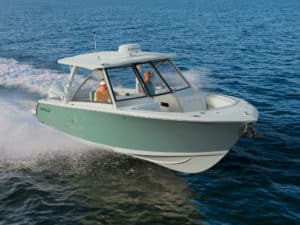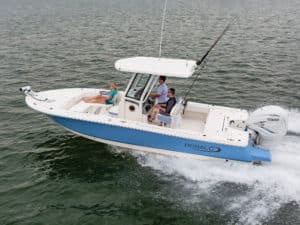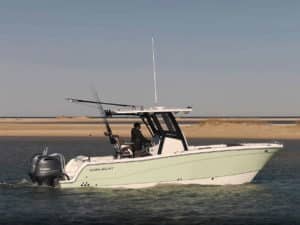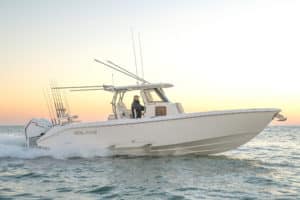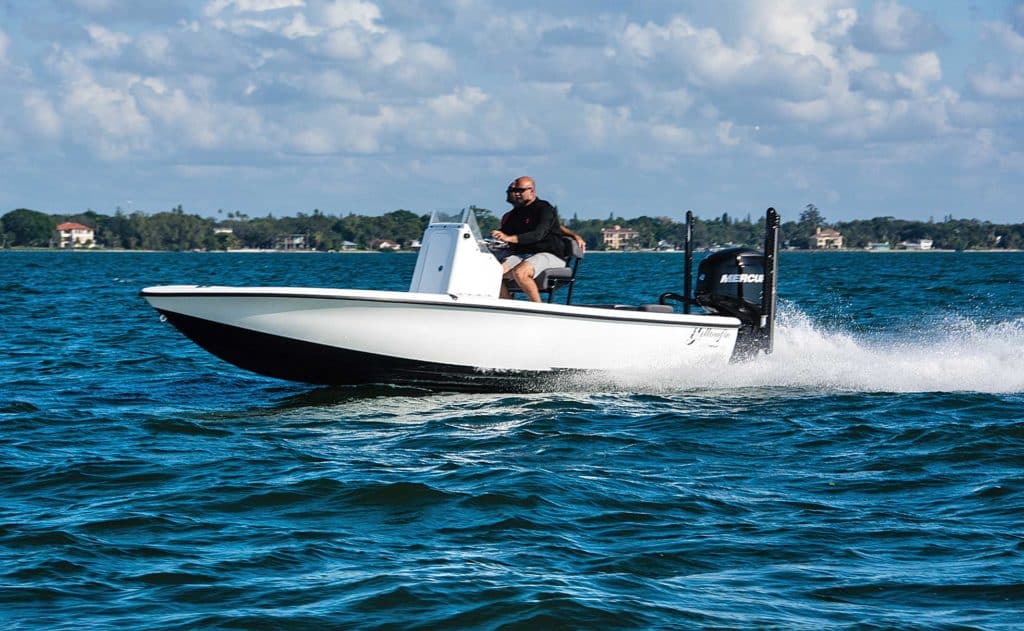
The midmorning sun revealed shadowy profiles of big snook in a wide sandy depression amid grass flats in the shallows of Florida’s Sarasota Bay.
“Get ready,” Capt. Mark Liberman whispered as he set the Power-Pole shallow-water anchor to hold the Yellowfin 21 Bay some 50 feet from the school. I cast a suspending twitchbait and then worked it back through the sandy hole.
My heart skipped a beat as one fish bolted from the school to chase the lure, but spirits fell when it stopped short and turned away, then disappeared with its schoolmates over the dark grass.
A shot at a big snook was just a bonus on this late November day aboard Yellowfin Yachts’ newest model. We’d already enjoyed a fun morning catching seatrout and flounder.
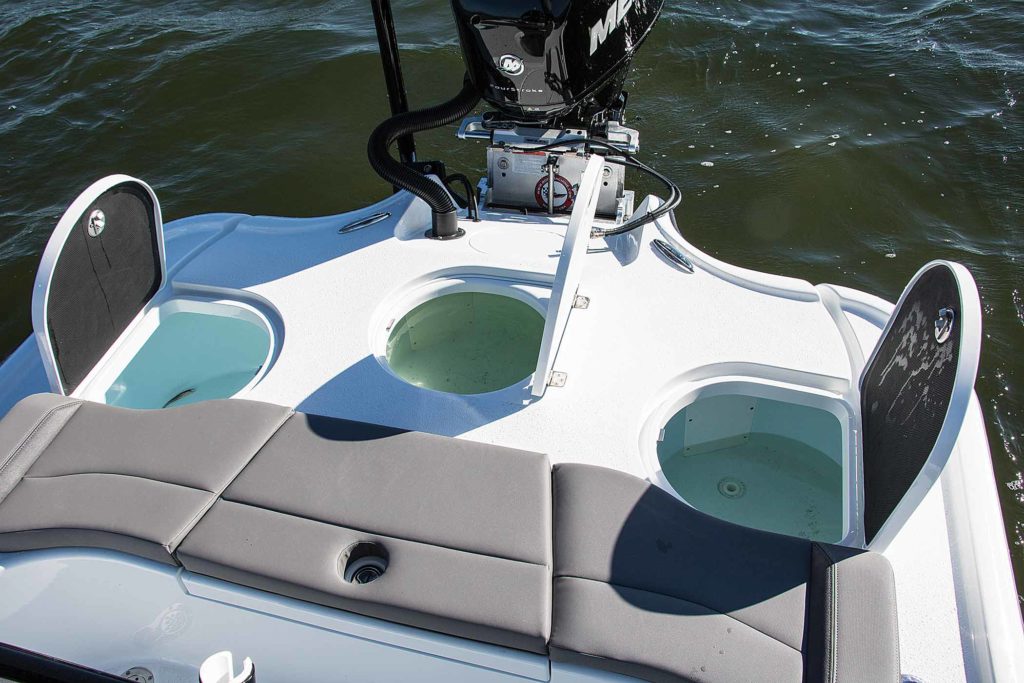
Bay Runner
Let’s rewind a few hours to earlier in the morning as Liberman and I departed the harbor at Sarasota’s Centennial Park launch ramp. “Hang on, let’s see how she runs,” he said, pointing the 21 Bay northward, then pegging the throttle on the Mercury 200 Verado four-cylinder outboard.
The Yellowfin blasted out of the hole and streaked to speeds in the low-50 mph range, riding on a cushion of aerated water thanks to its stepped hull.
A flush-mounted Garmin GPSMap 7612xsv multifunction display guided the way, while a Mercury VesselView display helped us keep tabs on the engine.
At this eye-watering clip, it didn’t take long to reach the first fishing area — Long Bar. “Definitely a rocket ship,” I said as the captain pulled back the throttle and set the 21 Bay on a drift along the outer edge of the bar.
My test boat had not yet been equipped with a trolling motor, but just about everything’s ready for installation, including a dedicated battery compartment under the floor of the cavernous forward stowage locker. A pad on the forepeak makes it easy to bolt on the motor.
As we drifted over a particularly shallow area, I stuck the rod in the water, down to the sand, to measure the depth. It was slightly over a foot and we were still floating freely with the outboard tilted up.
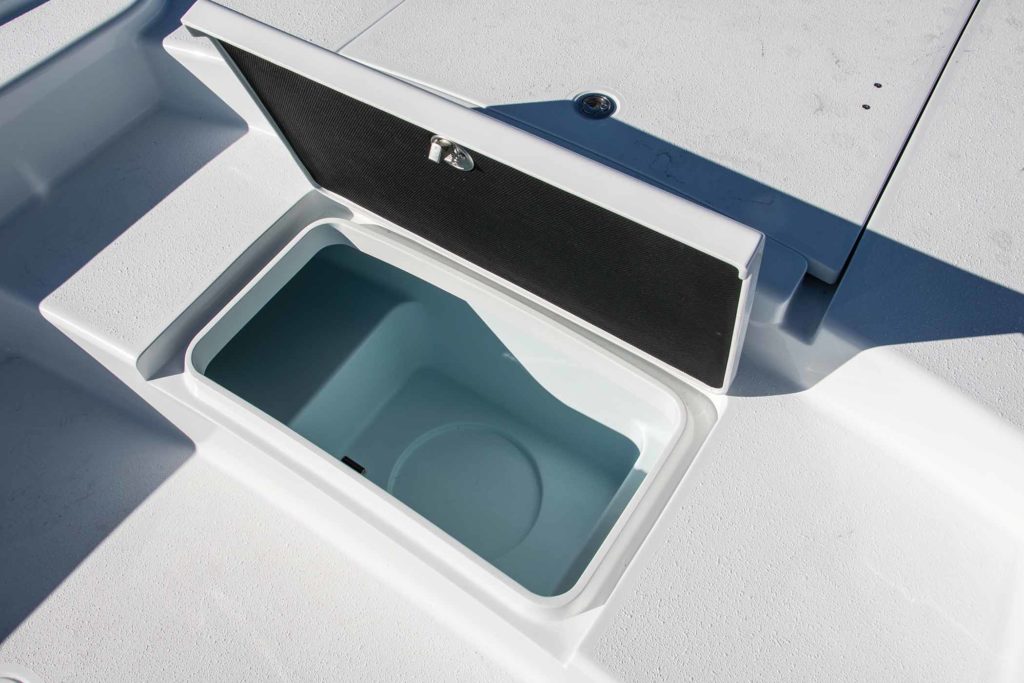
Console Difference
Both the new Yellowfin 21 Bay and its predecessor, the 21 Hybrid, come with center consoles, but the height of the consoles and helm seating are points of distinction. Behind the low-profile Hybrid console, the helmsman sits on the leading edge of the aft casting deck, much like he would in a flats boat.
The 21 Bay offers a more elevated center console, allowing the captain to stand at the wheel if he wishes. There’s also devoted helm seating. My tester featured a leaning post that can seat two, but a variety of custom configurations are available.
Inside the console of the 21 Bay I found room for abundant rigging. Yellowfin had installed two 31-series starting batteries, along with a battery-switching system and immaculate, well-labeled rigging, a hallmark of all its models. Gunwale-style rod holders line both sides of the console (there’s room for eight rods total).
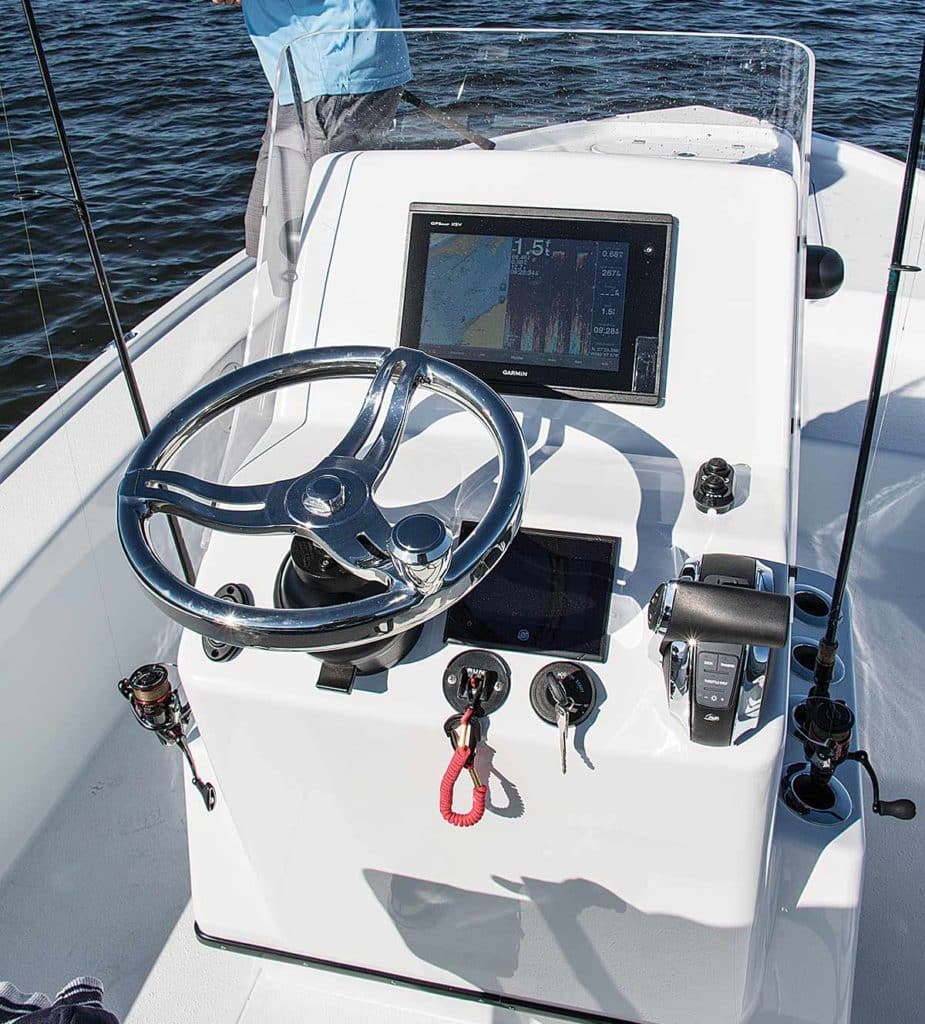
Wide-Open Spaces
The bow deck allowed plenty of room and stability for both of us to stand side by side and cast. A step up from the deeper central cockpit makes it easy to access the bow platform. This is a departure from the 21 Hybrid, which has no step to access the foredeck.
The aft casting platform also offers abundant space, terminating with the integral outboard bracket. Both decks offer toe kicks to remind you when your feet reach the edge. My test boat also included upholstered seats on the leading edge of the aft deck that provide a comfy place for as many as three crew members. Forward of the seating, the black powder-coated frame of the leaning post provided a convenient place to hold while underway. The leaning post also includes four rod holders across the back.
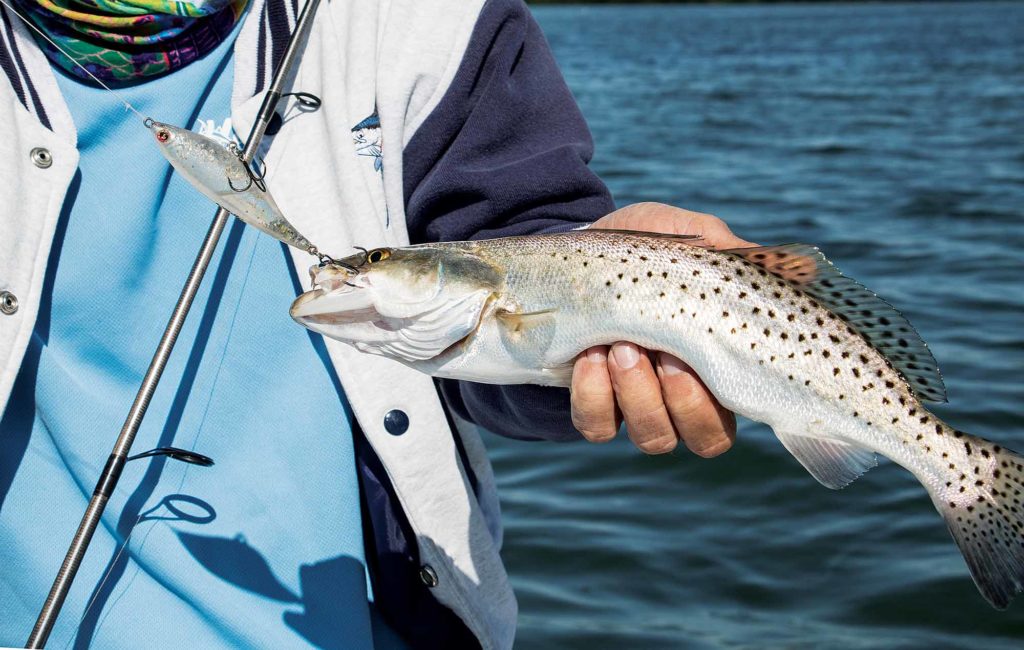
Beaucoup Bait
While we did not use live bait, the 21 Bay would certainly have proved worthy for this style of fishing. First off, thanks to flush-mounted pull-up cleats and navigation lights mounted on the console, the gunwales remain snag-free to help facilitate cast-netting. Nestled into the step that leads to the forward casting platform I found a locker that’s designed to hold a five-gallon bucket — a perfect place to stow a net — and other gear.
Secondly, my test boat had three large, rounded livewells — a 35-gallon well in the center of the aft deck flanked by two additional wells. That gives you plenty of chummers, as well as hook baits. The two side wells could also be employed as release wells.
Seal of Approval
All of the hatches on the 21 Bay feature closed-foam EVA on the underside. This seals the compartment and serves two purposes. With livewells, it keeps the water from sloshing out; with dry lockers it keeps water from leaking in. The EVA underside also deadens the sound when you close the hatch to prevent spooking fish.
Lack of live bait didn’t seem to hamper Liberman’s ability to catch fish; he consistently hooked seatrout and flounder on his soft-plastic, lead-headed grub. In the meantime, I managed to catch a fair share on a topwater lure.
Read Next: Yellowfin 26 Center Console Review
On the other hand, a livewell full of pilchards might have been just the trick to fool a big snook or two. The good news is that the 21 Bay did not exhibit a hint of fish-startling hull slap. This allowed us to get within easy casting range of schools before using the Power-Pole to halt our drift and make presentations to fish.
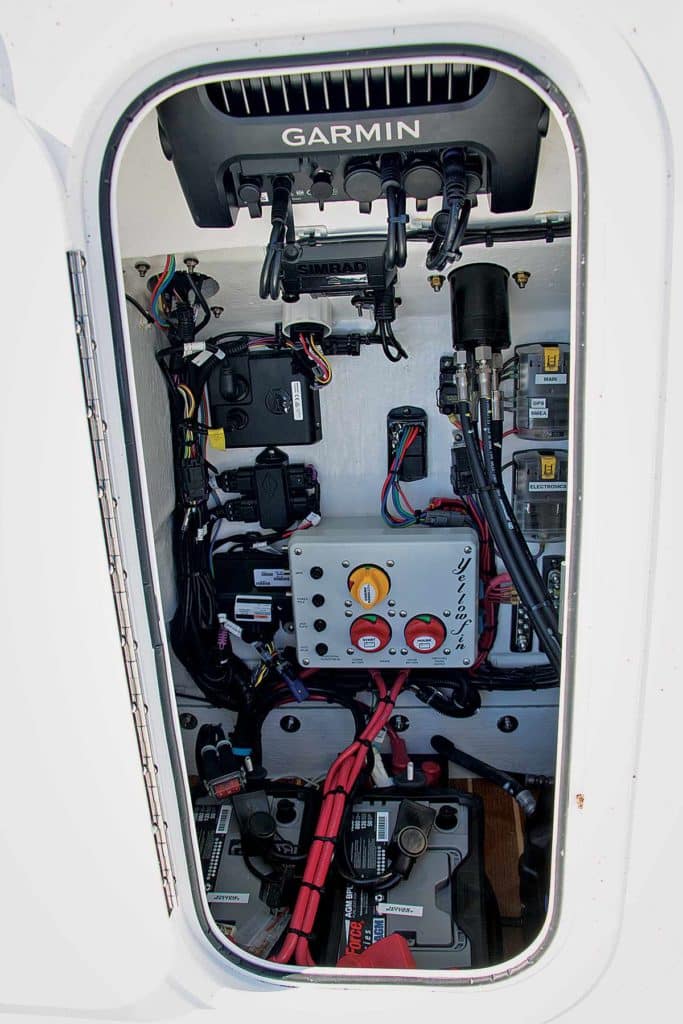
Run the Numbers
We used the late morning hours to gather performance data while hugging the eastern shore of the bay to find calm water. Turning a 21-inch-pitch Bravo One four-blade stainless-steel propeller, the Merc 200 Verado offers a head-snapping hole shot, vaulting the 21 Bay to plane in three seconds and 30 mph in six seconds. Top speed measured 53.9 mph at 6,200 rpm, at which point the Merc consumed 19.7 gallons per hour for 2.7 mpg.
The best cruising fuel efficiency occurred at 3,500 rpm and 27.5 mph, where the 200 Verado burned 5.1 gph for a remarkable 5.4 mpg. That will give you a cruising range of more than 250 miles based on the 50-gallon fuel tank.
I took the helm on the run home and found that the 21 Bay runs especially well in the 1- to 2-foot chop with the outboard trimmed high, coaxing the hull to skim the wave tops. The more speed I gave it, the smoother the ride. Handling was precise, predictable and fingertip-easy thanks to the Verado power steering.
Well-constructed and boasting outstanding fit and finish, the Yellowfin 21 Bay serves the angler who wants to stand up at the helm while racing across inshore waters to fish inlets or make a rare offshore run, but mostly to sneak into the shallows to stalk redfish, seatrout, snook and tarpon.
Performance
Power: Mercury 200 Verado
Load: 35 gal. fuel, 2 crew
Top Speed: 53.9 mph @ 6,200 rpm
Time to 30 MPH: 6 sec.
Best MPG: 5.4 @ 27.5 mph (3,500 rpm)
Hull
LOA: 21 ft. 9 in.
Beam: 7 ft. 9 in.
Deadrise: 15 deg.
Dry Weight: 2,525 lb. (w/ engine)
Draft: 1 ft. 1 in
Fuel: 50 gal.
Max Power: 350 hp
MSRP: $75,911 (as tested)
Yellowfin Yachts
Bradenton, Florida
941-753-7828
yellowfin.com

